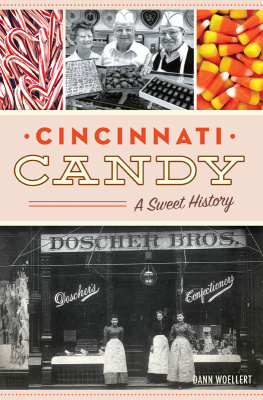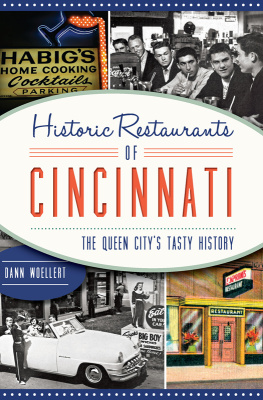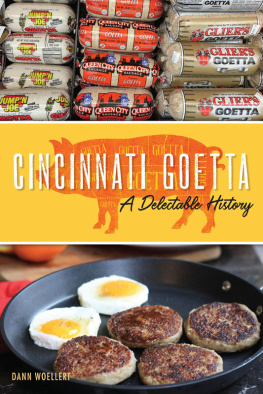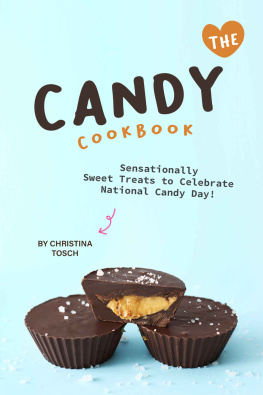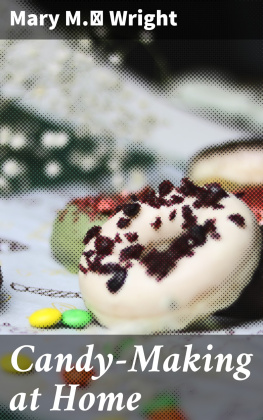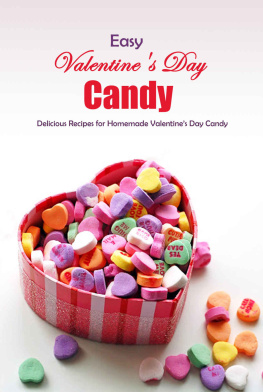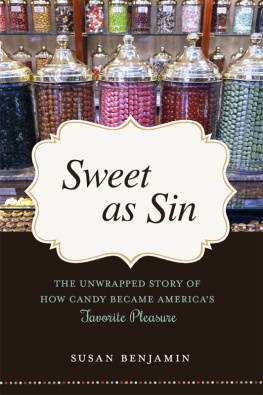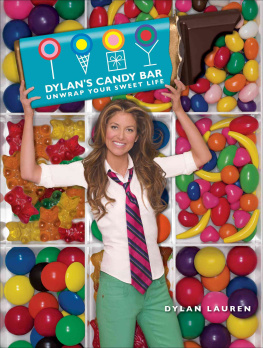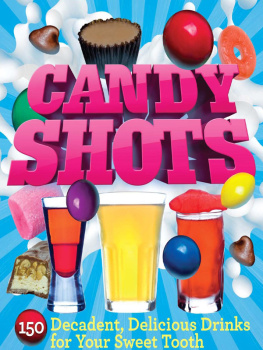


Published by American Palate
A Division of The History Press
Charleston, SC
www.historypress.net
Copyright 2017 by Dann Woellert
All rights reserved
Front cover, left to right: Doscher candy canes. Jeremy Kramer; Schneiders Sweet Shop. Kenton County Public Library; candy corn. Authors collection; Doscher Brothers. Cindy Doscher.
First published 2017
e-book edition 2017
ISBN 978.1.43966.361.5
Library of Congress Control Number: 2017948448
print edition ISBN 978.1.46713.795.9
Notice: The information in this book is true and complete to the best of our knowledge. It is offered without guarantee on the part of the author or The History Press. The author and
The History Press disclaim all liability in connection with the use of this book.
All rights reserved. No part of this book may be reproduced or transmitted in any form whatsoever without prior written permission from the publisher except in the case of brief quotations embodied in critical articles and reviews.
To my nieces, Alaina and Kendall, and their sweet tooths.
CONTENTS
PREFACE
The candy that was invented the year I was born is the Laffy Taffy. It was invented as a tie-in to the candy movie released the same year, Willy Wonka and the Chocolate Factory. What kid can forget the scene where the group first enters the candy factory room with all the edible plants and the chocolate river? My favorite line from the movie is delivered by the German mother who warns her son, Augustus, save some room for later! We should all take heed of that warning.
Like the character Augustus Gloop, we all have different aspects of candy that we flock to. There are aspects of a candys gooiness, chewiness, crunchiness, saltiness, sweetness, sourness or bitterness. Recently, even savory flavors, like that of bacon and even fishiness or umami, have been integrated into candy.
For me, the perfect candy is a combo of crunchy, gooey, sweet and chewy. And it also has to do with the degree of chewiness. Too chewy is off-puttingmildly chewy is better. The Goo Goo Cluster or the turtle candy are examples of this, with their crunchy nuts, chewy caramel and gooey filling. Maybe the universal appeal of crunchy texture is what makes chocolate-covered potato chips and pretzels so popular. The snack candy category integrating nuts, chips, pretzels and chocolate is a growth area for companies like Hersheys.
My top five favorite candies are anything toffee, like the Heath bar (crunchy, chewy), Goetzs bullseyes (chewy, gooey), Swedish fish (chewy, fruity), opera creams (gooey, creamy) and black licorice (chewy, bitter, salty). A close sixth is the Butterfinger bar and the related Chick-O-Sticksground roasted peanuts and candy extruded in a stick and dusted with coconut (crunchy, crispy, chewy, salty, peanut). I do like Almond Joy (born in 1946) and Kit Kat because of both having the crunchy aspect. I found my favorite flavor of Kit Kat in Japan in the form of the Green Tea Kit Kat, which can now be found locally at Jungle Jims Markets. I do like Swedish fish and fruit slices, but Ive never been a fan of gummy bears. Their chew is too polymeric and rubbery.
Im not a huge fan either of dense taffy that takes more than a couple of chews to dissolvelike a Bit-o-Honey or a French Chew. I know thats Cincinnati fighting words, but I do like the new, smaller taffylike French Chews that Doscher started making a few years ago.
Every Easter as a kid, I knew that there would be several opera creams in my Easter basket from Schneiders Sweet Shop in Dayton, Kentucky, right across the river from Cincinnati. My mother grew up in a baking family. Her familys bakery was only a few blocks from Schneiders on the Avenue, on the border of Bellevue and Dayton, Kentucky. My mother loved these sweet confections, and her love was instilled in all of us at Easter. My dads favorite is the turtlethe chewy, crunchy, caramely glob of deliciousness.
We also knew that my paternal grandmother would give us buttercreams in shapes of chicks, bunnies and ducks, probably made by the Kroger company. Grandma knew the legacy of buttercream candy manufacturing in Cincinnati in the early part of the twentieth century from companies like Goelitz, Nuss and Messer and developed a liking to that type of candy, passing it on to us.
My maternal grandfather ate Zero bars regularly. Now theyre hard to come by. My brother-in-law is a huge fan of marshmallow circus peanuts, which I never developed a taste for. My sister is more a fan of hard candy than I am. I guess Im too much a hedonistI was always the one biting into the center of a Tootsie Pop, rather than waiting for it to dissolve. But I also do not like the flavors integrated into hard candy. The American Concord grape flavor is my least favorite candy flavor, but I do like a green apple Jolly Rancher.
During the snowy winters of my childhood in the 1970s, my next-door neighbors made snow candy. They poured hot maple syrup onto snow, letting it harden into weird shapes. My grandmother made potato fondant candy and butterscotch-enrobed Chinese noodles with peanuts. My niece and sister-in-law make them for Christmas and theyre fantastic!
There are even preferred ways to eat candy. For example, 70 percent of people prefer to eat the ears off a chocolate bunny first. And who can forget the famous commercial with the owl asking how many licks it takes to get to the center of a Tootsie Pop?
There are many I would like to thank for their help in this history of the Cincinnati candy industry. Ron Case, son of George and Marilu Case, former owners of Mullanes, helped fill in the history of one of our oldest surviving confectioners. Warren and Jill Schimpff, of the Schimpff Candy Museum in Jefferson, Indiana, provided wonderful Cincinnati candy industry artifacts for photographing that they have wonderfully preserved in their Smithsonian-quality candy museum. Martha Becksmith Uhl, great-granddaughter of Cincinnati candy jobber Fred W. Becksmith, provided wonderful insight into the role of the jobber in the local industry and a great photo of her ancestors beautiful candy truck. Greg Cohen of Lofty Pursuits in Tallahassee, Florida, who purchased the candy rolls of Mullanes, provided great industry information and contacts to the Mullane company history. I always have to thank the amazing staff at the Cincinnati Public Library downtown. Were lucky to have such a great library and such awesome staff. Sam Droganes, grandson of Soterios Droganes, provided great images and information about his Greek immigrant grandfathers candy business. Angela Westpfall of the Zion Illinois Library provided the image of Roscoe Rodda, inventor of the Marshmallow Peep. Bob Schneider was an asset in learning the true story of the opera cream in Cincinnati.
Gil Pietrzak of Carnegie Library of Pittsburgh provided the image of Ed Messer. Lisa Marine of the Wisconsin Historical Society provided the image of the Niehaus truck. Alice Ruzic Herfurt, Molly Herfurt Imhoff, Brian Herfurt and John Herfurt, descendants of Gerald Mullane, provided even more great images and information about the Mullane company. Jana Sanders Perry at the Jelly Belly Corporation in California provided images of the Goelitz family and connected me to the company archives to learn about the Goelitz time in Cincinnati. My uncle Jerry Ling, former owner of Lings Pastry Shoppe and a former Kroger food scientist, provided assistance in decoding a legacy opera cream recipe and a background on stabilizers used in confections.
Next page
